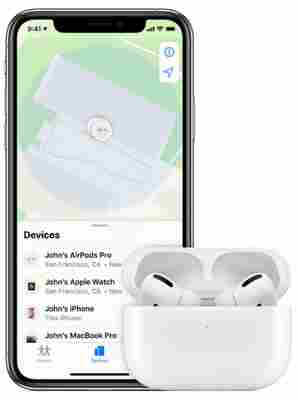While I liked the AirTags overall , they’re flawed. Despite this truth (and I’m sorry to tell you, but it is a truth), this is also a one-dimensional way of looking at Apple’s location trackers. Why? Because the product and the Find My service are ushering in a whole new Apple era.

To understand why this is the case, we need to understand a few things. Specifically, why and how Apple has gone about releasing the AirTags.
Before that though, if you’re uncertain about the hardware or how it works, I’d advise you to watch our video on them:
Now we’ve got all the context we need out of the way, let’s begin by talking about Apple’s Find My service.
Find My is finally useful
Before the AirTags, my experience with Find My had been uniformly bad. I’ve had Apple products stolen in the past and the service did nothing to help me out.
Its implementation tends towards the scattershot. Take the AirPods Pro for example. If you’ve lost them, you have the option to make them play a sound through the Find My app. The issue is this only works if the AirPods themselves are out of the case.
This is typical of Apple’s approach to Find My: half-assed and nonsensical. There’s no reason why the AirPods Pro shouldn’t bleep whether they’re in the case or out.


Find My has suddenly become far more useful since the arrival of the AirTags. In my mind, they’re the first product that actually work well with the service, despite their flaws .
But this raises another question…
Why did Apple bother releasing the AirTags?
The simple answer to this is money. Apple has a multitude of fans that’ll buy anything the company makes. AirTags provide the company revenue and, in turn, this will increase stock price.
But there’s more to it than that. To understand this though, we need to ask one more question. I know, I know — don’t look at me like that.
So why has Apple chosen 2021 to release the AirTags and beef up its Find My service?
The AirTags have an interesting history. They were first rumored in 2019 and there’s undeniable evidence the location trackers have been ready to go since then:
I believe there are two main reasons for this: technology and privacy.
Let’s consider the first point. Not only have technological standards improved in the past two years, but Apple’s U1 chip — the magic behind the AirTags‘ flagship precision finding feature — is far more widespread.
This chip made its debut in Apple’s iPhone 11 range, devices that were released in 2019. When you consider this, waiting until 2021 to launch the AirTags makes sense: you need to have enough phones capable of using them in the public’s hands if they’re going to gain any traction.
But now let’s talk about the second — and arguably more important — reason why Apple has waited until now to release the AirTags: privacy.
If you’ve watched the video , you’ll know that one of the key features of AirTags is the Find My network. In summary, the billion Apple devices across the world form a mesh and when your lost item is near one of them, its location is marked on your Find My app.
While the people whose devices are marking your lost item won’t be able to see it, this is still a privacy concern — something plenty have drawn attention to .
But the uproar over Apple’s Find My network has been generally muted. People seem comfortable, or even excited, about this feature. Which is strange when you consider the fact that it’s a bonafide tracking network.
The reason for the acceptance? Apple’s recent focus on turning privacy into a product .
By going on the offensive , stopping apps from tracking you , and putting privacy at the front of its software , Apple has built up a gamut of public trust. We believe the company is doing the ‘right thing.’
This means it can release something like the AirTags that use a covert tracking feature and receive, comparatively, little backlash. Can you imagine what would happen if Facebook or Google released the same product? It would not get a reception like this.
Now we understand why Apple released the AirTags in 2021, we can circle back to the original question.
Why the AirTags are the start of a new Apple and the Find My revolution
When we look back at Apple history in a decade’s time, the launch of the AirTags and expansion of the Find My network will be a pivotal moment.
I expect that in the next few years, every Apple device will have AirTag technology built in. Think, for example, of being able to use precision finding to track down your AirPods or Siri Remote without a physical AirTag attached.
It’s a matter of when, not if, this happens
Of course, the release of the AirTags is a solid business move that’ll help Apple sell more shit, but it’s not the sole reason why this is such an important moment. That, in my mind, is also down to how Apple has managed to shift our view of its products.
One of the biggest selling points of Apple devices is how they work together. The company isn’t selling you a single bit of hardware, it’s pushing an ecosystem, something regularly referred to as a walled garden.
For example, a reason I’m so fond of the AirPods Pro is how seamlessly they work across all my other Apple devices.
But AirTags are different. These are the first Apple product whose selling point is all the other Apple devices around the globe. That’s a subtle, but important shift. I’m directly benefitting from people around me carrying Apple gear.
Let me put it this way, with the expansion of the Find My network, we’re no longer just in a walled garden, but a walled garden world.
Conclusion
It’s interesting to see how Apple’s privacy strategy is panning out. Two years ago, few would have predicted its concentration on the topic would lead to new products, but here we are.
At this stage, it’s tricky to know what other features and products Apple will rustle up from its Find My revolution, but one thing’s for certain — it’s gonna find a way to sell them to you.
And you know what? It’s hard to be mad when so much of it is so good.

